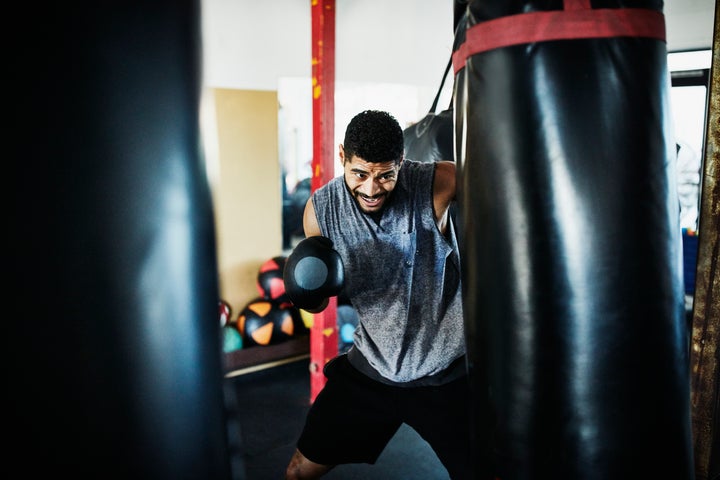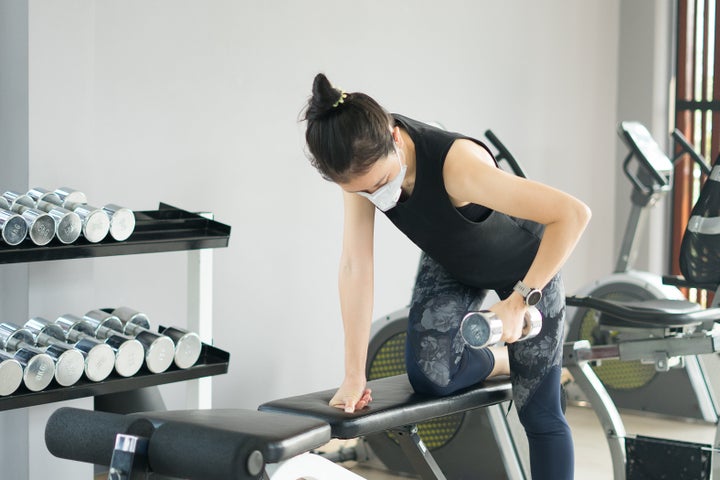As states across the country begin to reopen amid the coronavirus pandemic, there’s a lot of questions surrounding what daily life will look like, and how it could be different from anything we’ve experienced before. With an emphasis placed on health precautions, all types of businesses have been tasked with implementing new guidelines in order to prioritize the safety of their customers — and that includes gyms and fitness studios.
Some states like Texas and Florida have already begun opening their exercise facilities, while others, like Massachusetts, are waiting until a later “phase” of the reopening process. But even when your local gym opens its doors, safety still remains a priority.
COVID-19, the disease caused by the coronavirus, is mainly spread through person-to-person contact, and gyms can be highly populated areas. Dr. Kelly Cawcutt, the associate director of infection control and assistant professor of infectious diseases and critical care medicine at University of Nebraska Medical Center, tells HuffPost that she has concerns about crowded classes or gyms where airflow might be less than ideal.
“Exercise increases the frequency and depth of breathing, so there is potential impact of increased aerosol at this time,” she said. Aerosols are small particles people expel that could contain the virus.
“Masks would be ideal, but we also know those can be difficult to wear during exercise and may not be mandated,” she added.
While it is not the primary means of transmission, COVID-19 can be spread via surfaces as well. Mark S. Dworkin, a professor and associate director for epidemiology at UIC School of Public Health, pointed out that clients might come in contact with equipment and machines that others have touched.
“This virus can likely survive longer on a moist surface, so sweat on equipment is problematic,” said Dworkin, who has authored two books on infectious diseases. “Gym reopening should be decided based on how severe the outbreak is in the area. Where there is an abundance of testing and relatively low transmission according to local health jurisdiction, the safety of reopening is higher.”
So what exactly will gyms look like in a post-lockdown world? HuffPost asked experts to break down what the “new normal” will look like while working out.
Cleanliness will be key.
Vigorous and frequent cleaning will undoubtedly be necessary to create a safe and healthy environment in gyms.
Dworkin said “providing sanitizing wipes for clients to apply to the surfaces they touch” will be key and Cawcutt advised facilities should offer “easy access throughout the gym to hand sanitizer and wipes.” She added that gyms should make their policies clear to let clients know how frequently the studios are cleaned.
Many fitness companies, both large and independently owned, are already publicizing such plans. SoulCycle, a spinning studio with locations across the country, announced a series of modifications like disinfecting equipment between classes even when not in use. Planet Fitness, a gym with locations in all 50 states, will encourage its members to thoroughly clean their machines after working out.
Emily Bench-Lahrssen, founder of Miami-based pilates studio Pilathon, tells HuffPost that when her business eventually reopens, they will be cleaning equipment with “top grade disinfectant” before and after every class. Floors and common spaces will be cleaned in the morning, at midday and before night classes.
Hands-free check-in systems will become the norm.
To limit the amount of person-to-person contact, gyms will likely implement digital check-in systems, along with changes to front desk interactions.
“For the time being, mats, water and towels won’t be provided, so we are asking our clients to bring their own,” Bench-Lahrssen said, noting that Pilathon will utilize contactless check-in. “High-touch amenities such as lockers, showers, sauna, and the front desk sitting area won’t be in use for the time being.”

Social distancing will be enforced while working out.
Experts recommend that people remain 6 feet apart from one another to minimize the possibility of infection through respiratory droplets.
“During exercise, there should be the capacity to have social distancing in place, or some kind of barrier between equipment to help decrease the risk for spread from someone who is asymptomatic,” Cawcutt said.
SoulCycle’s safety plan includes the placement of floor markers throughout the studio, as well as in locker rooms and restrooms. Equinox, a gym with locations throughout the U.S. and internationally, plans to implement “physical distancing cues” in its clubs as well.
Bench-Lahrssen said that Pilathon will separate equipment by the necessary 6 feet, and add signage to the floors to encourage students to maintain distance while in class.
“We are also separating the benches where clients sit to remove their shoes,” she said. “Only one person per bench will be allowed.”
Class schedules could change too.
Cawcutt strongly advised that if gyms cannot enforce distancing measures, they should limit the amount of clients inside at one time. Bench-Lahrssen is also thinking ahead to this tactic, and said her studio will allow six students per class, with the goal of a maximum of eight people in the studio at a time.
“There will be a 20-minute gap between classes,” she added, noting that some classes might be held outside. “This is to avoid encounters in the hallway and common areas.”
Staff may be required to wear face masks and, at the very least, it should also be encouraged for members.
Both Dworkin and Cawcutt urge gym owners to ask everyone — staff and clients — to wear masks. They aren’t a replacement for social distancing, but act as an added layer of protection for the wearer and anyone they interact with.
Equinox’s safety plan suggests that staff members will be required to wear masks and gloves, and members “will be required to wear face coverings all times in the club, except while vigorously training.” SoulCycle will also be requiring its staff to wear masks and gloves, noting that team members will refresh their equipment between classes as needed.
Bench-Lahrssen will be requiring her staff to wear masks — and her clients will be urged to wear them too.
“Even though not government-mandated, we will encourage our clients to do the same specially if interacting with people they don’t live with,” she said.

Some form of screening may happen at various locations.
As temperature checks become more common throughout businesses, gyms will likely implement medical screenings of staff members upon entry. In Dworkin’s opinion, gyms should be “asking screening questions to identify anyone who may be ill — and exclude them if they may be ill.”
SoulCycle has said it will check temperatures of all staff members — and clients as well, in states where checks are mandated. They will also ask clients to sign health declarations before each class, “stating that you agree to the health and safety parameters put in place by our governments.”
Gym clients should also keep in mind the things they can do on their own to stay safe.
In addition to following the guidelines of your gym or fitness studio, there are some extra measures that clients can take to protect their health and the health of others. Cawcutt emphasized that anyone who feels ill, or who has had known exposure to COVID-19, should absolutely stay home.
Dworkin also noted that some folks with compromised immune systems might want to continue avoiding gyms for the time being — even if their local studio reopens.
“If someone has … high-risk conditions, social distancing is especially important and they should consider exercising at home or outdoors instead of risking contact with people in a gym,” he said.
Cawcutt added that carrying your own hand sanitizer, wearing a mask, implementing frequent hand-washing, and avoiding touching your face are all helpful strategies, along with visiting the gym during less popular hours.
“Help others by continuing to be an example of safe exercise habits,” Cawcutt said. “Advocate for detailed, well-thought-out safety and cleaning plans for the gym, and have patience with everyone as we continue to advance through this trying time.”
Experts are still learning about the novel coronavirus. The information in this story is what was known or available as of press time, but it’s possible guidance around COVID-19 could change as scientists discover more about the virus. Please check the Centers for Disease Control and Prevention for the most updated recommendations.
A HuffPost Guide To Coronavirus
Credit: Source link